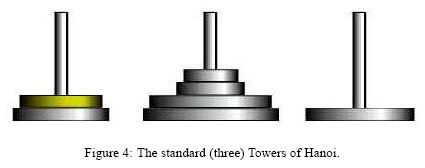Background
Charlie Darkbrown sits in another one of those boring Computer Science lessons: At the moment the teacher just explains the standard Tower of Hanoi problem, which bores Charlie to death!

The teacher points to the blackboard (Fig. 4) and says: "So here is the problem:
There are three towers: A, B and C.
There are n disks. The number n is constant while working the puzzle.
All disks are different in size.
The disks are initially stacked on tower A increasing in size from the top to the bottom.
The goal of the puzzle is to transfer all of the disks from tower A to tower C.
One disk at a time can be moved from the top of a tower either to an empty tower or to a tower with a larger disk on the top.
So your task is to write a program that calculates the smallest number of disk moves necessary to move all the disks from tower A to C."
Charlie: "This is incredibly boring—everybody knows that this can be solved using a simple recursion.I deny to code something as simple as this!"
The teacher sighs: "Well, Charlie, let's think about something for you to do: For you there is a fourth tower D. Calculate the smallest number of disk moves to move all the disks from tower A to tower D using all four towers."
Charlie looks irritated: "Urgh. . . Well, I don't know an optimal algorithm for four towers. . . "
Problem
So the real problem is that problem solving does not belong to the things Charlie is good at. Actually, the only thing Charlie is really good at is "sitting next to someone who can do the job". And now guess what — exactly! It is you who is sitting next to Charlie, and he is already glaring at you.
Luckily, you know that the following algorithm works for n <= 12: At first k >= 1 disks on tower A are fixed and the remaining n-k disks are moved from tower A to tower B using the algorithm for four towers.Then the remaining k disks from tower A are moved to tower D using the algorithm for three towers. At last the n - k disks from tower B are moved to tower D again using the algorithm for four towers (and thereby not moving any of the k disks already on tower D). Do this for all k 2 ∈{1, .... , n} and find the k with the minimal number of moves.
So for n = 3 and k = 2 you would first move 1 (3-2) disk from tower A to tower B using the algorithm for four towers (one move). Then you would move the remaining two disks from tower A to tower D using the algorithm for three towers (three moves). And the last step would be to move the disk from tower B to tower D using again the algorithm for four towers (another move). Thus the solution for n = 3 and k = 2 is 5 moves. To be sure that this really is the best solution for n = 3 you need to check the other possible values 1 and 3 for k. (But, by the way, 5 is optimal. . . )
Input
There is no input.
Output
For each n (1 <= n <= 12) print a single line containing the minimum number of moves to solve the problem for four towers and n disks.
Solution
首先考虑n个盘子3塔的经典Hanoi问题,设(d_n)表示求解n个盘子3塔问题的最少步数,显然有
含义为把前(n-1)个盘子从A借助C转移到B,再将第(n)个盘子转移到C,最后把(n-1)个盘子从B借助A转移到C。
类似地,对于本题,设(f[n])表示求解n个盘子4塔问题的最小步数,则有
含义为把前(i)个盘子在4柱的情况下从A转移到B,再将(n-i)个盘子在3柱的情况下从A转移到D,最后再将(i)个盘子在4柱的情况下从B转移到D
Thinking
那么对于n盘m塔的问题((m>4)),就有
使得我们可以在(O(n^2*m))的复杂度内求解该问题
Code
附上POJ1958的代码
#include<cstdio>
#include<algorithm>
#include<cstring>
using namespace std;
int d[20],f[20];
int main()
{
d[1]=1;
for (int i=2;i<=13;i++) d[i]=2*d[i-1]+1;
f[1]=1;
for (int i=2;i<=12;i++)
{
f[i]=1e9;
for (int j=1;j<i;j++)
f[i]=min(f[i],2*f[j]+d[i-j]);
}
for (int i=1;i<=12;i++)
printf("%d
",f[i]);
return 0;
}